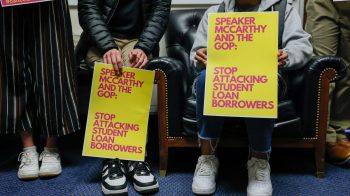The trouble with refinancing a student loan
It doesn’t seem fair, right? The U.S. Treasury gets to borrow money at about 2 percent interest these days. That’s latest yield on the 10-year Treasury note. When the government turns around and loans that money to college students, most of them are paying well over 6 percent interest. Meanwhile, the average fixed rate on a 30-year mortgage these days is just over 3.5 percent.
To understand why student borrowers pay so much more, I started with my go-to guy for all things financial aid, Mark Kantrowitz of FinAid.org. He says there are two big reasons federal student loans cost more than, say, a mortgage or car loan. Nobody checks your credit. And there’s no collateral.
“If you default on a federal education loan, they can’t repossess your education,” he says.
Other kinds of unsecured debt — like credit cards — usually cost much more, he says. “For someone with a typical credit pattern of a college graduate, we’re talking a 10, 11 percentage interest rate — maybe even as high as 14 percent.”
Even at comparatively low rates, more people are defaulting on their education loans. And unlike other types of debt, you can’t escape student loans by filing for bankruptcy.
One youth advocacy group is pitching an idea to make it easier to pay them off — a federal loan refinancing program.
“If you refinance loans down to 5 percent — so just the loans that are above that — that would save people about $14 billion in interest rate payments for this year alone,” says Tobin Van Ostern, deputy director of Campus Progress. It’s part of the liberal Center for American Progress.
“It would be huge,” says Jennifer Belmont Jennings, an attorney in St. Louis. “For us, personally, it would just add a significant level of security to us.”
Belmont Jennings finished law school just as high-paying legal jobs seemed to evaporate. She owes about $170,000 in student loans, and says she could really use a few hundred extra dollars a month.
“Just from a spending standpoint of being able to do things, you know,” she says. “We bought a house several years later than we would have had we had that extra money.”
When they did buy a house, this year, they got a mortgage rate of 3.7 percent.
It is possible to refinance student loans — privately. SoFi makes loans to students and graduates of certain colleges. The loans are funded by alumni of those schools. For a re-fi CEO Mike Cagney says the average borrower comes in with a rate of about 7.2 percent.
“We’re refinancing them into rates between 6 and 6.5,” he says. “And the borrower’s savings have been about $10,000 over the life of the loan.”
But to qualify you have to have gone to one of the 79 schools SoFi works with, like Carnegie Mellon or the University of Michigan. To refinance on a large scale, Cagney says, the federal government would need to step in.
There’s a lot happening in the world. Through it all, Marketplace is here for you.
You rely on Marketplace to break down the world’s events and tell you how it affects you in a fact-based, approachable way. We rely on your financial support to keep making that possible.
Your donation today powers the independent journalism that you rely on. For just $5/month, you can help sustain Marketplace so we can keep reporting on the things that matter to you.


















